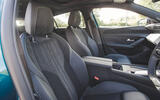Isn’t this all reassuringly traditional? You could almost start to forget that five-door family hatchbacks are a thing, but here are three of them and there’s not a raised ride height or charging plug in sight.
They are very much still a thing, though, particularly the Golf. While Toyota and Peugeot buyers have more decisively migrated to smaller cars and crossovers, the Golf remains Volkswagen’s biggest-seller in the UK.
Long may they reign because, as we will rediscover, these kinds of cars are about as archetypically ‘car’ as it gets. The biros of the automotive world: fit for just about any purpose.
You might want a fancy fountain pen, but the good old ballpoint at the bottom of your bag will probably do fine, whether you’re scribbling something down or doing a line drawing.
We have convened this test around the facelifted Golf. Launched in 2020, the Mk8 Golf is emblematic of Volkswagen’s recent struggles.
An unhealthy cocktail of shrinking profit margins and the need (perceived or otherwise) to electrify and digitalise has squeezed the company into taking some drastic actions. And many of those befell the arch-Volkswagen.
The often glitchy and confusing multimedia, the cheapening of the cabin and the infernal touch-sensitive steering wheel buttons mean it hasn’t been as well liked as previous iterations.
At the same time, the Mk8-bashing bandwagon has proven a popular one for the media and other observers, and when looked at with fewer preconceptions, the Mk8 Golf has always been a good car that provides a compelling blend of space and driving manners. Even so, Volkswagen has listened to feedback and addressed many of the Mk8’s undeniable issues.
The old screen and its software have pretty much been binned and replaced, the contentious touch bar remains but now lights up to enable its use at night, and the interior has regained some sense of perceived quality and tactility, including steering wheel buttons for all.
On first acquaintance at its launch events abroad and in the UK, the ‘Mk8.5’ felt like a return to form for the Golf. A class leader? That’s a tougher call to make in isolation, so today we have brought along two rivals.
In the blue corner is the Peugeot 308, one of the more convincing cars to be spun off Stellantis’s front-wheel-drive architectures.






























































Join the debate
Add your comment
Nothing else, really, what rubbish.
Spec now published and it's a tough read for both the Pug and Toyota, they're both slower and way more expensive, to add salt to the wound the 1.5 COD Golf without the battery rubbish is another 1K cheaper and a better car without it.
Want another example of how overpriced they are, a BMW 1 series M Sport 120 is still 1k CHEAPER.
What the test does not mention is that the Toyota has a ten year warranty if you have the car serviced each year also it has a reliablr chain rathe rthan cam belt which is an £800 job every 4 to 5 years on the golf also the golf is old hat technology,the main negative on the corrola is the boot is not as good as the golf but otherwise a no brainer in the real worldnot to mention reliability that seals the deal for buying something with your own cash.
£800 every 4 years really.
Great tech on the VW - guaranteed to break
lolol